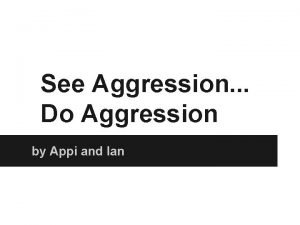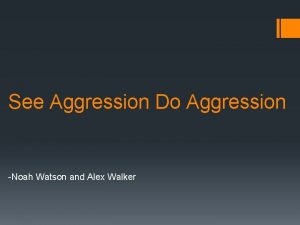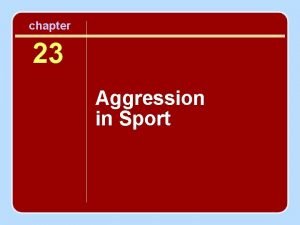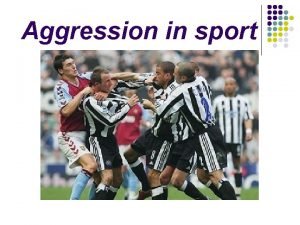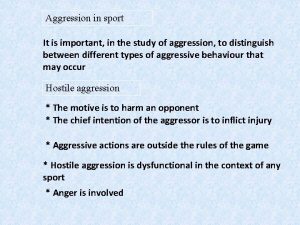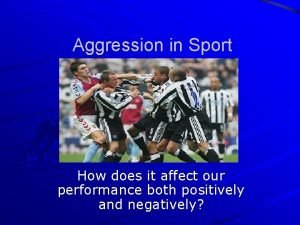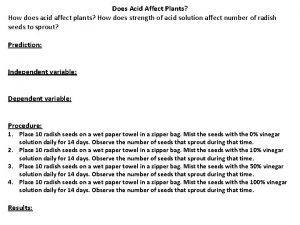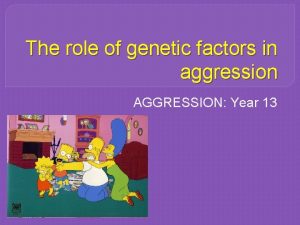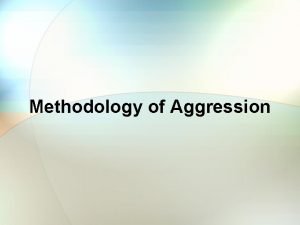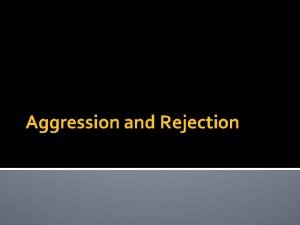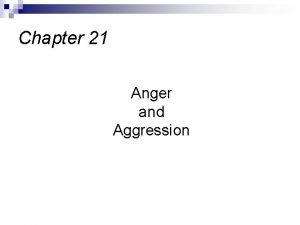Aggression in Sport How does it affect our













- Slides: 13

Aggression in Sport How does it affect our performance both positively and negatively?

Learning Intentions be able to define and describe, controlled and hostile aggression be able to explain the difference between aggression and assertion be able to describe and explain theories of aggression and suggest strategies to control aggression

Definition Psychologists define aggression as; “any form of behaviour directed towards the goal of harming or injuring another living being who is motivated to avoid such treatment” (Baron, 1977, p. 7).

Types of Aggression Hostile aggression Instrumental / Channeled aggression Assertive behaviour (controlled aggression)

Aggression in Sport Some assertive behaviours are tolerated by officials in sports such as the ‘Haka’the provocative display performed by the NZ ‘all blacks’ rugby team Other behaviours that are violent but are neither assertive (aim to influence/dominate) nor aggressive (intent to harm) are not tolerated e. g. , bad language, equipment abuse

Types of Aggression Assertive behaviour (controlled aggression) 1. No intent to harm 2. Legitimate force 3. Unusual effort and energy expenditure Hostile aggression 1. Intent to harm 2. Goal to harm 3. Unusual effort and energy expenditure Instrumental aggression 1. Intent to harm 2. Goal to win 3. No anger

Assertive Behaviour (controlled aggression) What many people call examples of good aggression (aggressively driving a golf ball or killing a shot in volleyball) are labelled assertive behaviours. Assertive behaviour is playing within the rules with high intensity, high arousal, without intention to do harm.

Aggression is not… Doing destructive damage to an inanimate object such as a door. Unintentionally injuring another person during athletic competition. Aggressive behaviour where there is no chance for the intended victim to be injured (e. g. , aggressor and victim separated by team-mates or officials).

Which of these are aggressive behaviours? 1. A basketball coach breaks a chair in protesting to a disputed call? 2. A hockey player, uses his stick to purposely hit his opponent in the shin in retaliation for his opponent’s doing the same thing to him? 3. A race car driver seriously injures a fellow competitor by running into the competitors stalled car coming out of a turn? 4. Barry knows that John is very sensitive and self-conscious about his ability to putt under pressure, so he tells John that the coach said that if does not putt better he will be replaced in the line-up. The coach never said this? 5. Jane bowls a fast ball in a cricket match that hits Tom on the head.

Answers 1. Not aggressive behaviour as violence is directed at an object and not a person. 2. Aggressive behaviour. The behaviour was aimed at injuring another player. 3. Not an aggressive action as there was no intent. 4. 5. Aggressive behaviour. There was deliberate to cause psychological damage. Not aggressive behaviour as there was no intent. A fast ball is part of the game. intent

What causes aggression? Frustration Social learning Over competitiveness Retaliation Anger

What type of aggression is this? Watch the video clip and try to explain Water Boy’s aggressive behaviour.

Summary Aggression is a behaviour where there is intention to harm another living being. It is fundamentally different from assertive behaviour (controlled aggression). Aggressive behaviour can be reduced by teaching emotional control strategies, by punishing negative behaviour and reinforcing positive behaviour.
 See aggression do aggression
See aggression do aggression See aggression do aggression
See aggression do aggression Types of aggression in sports
Types of aggression in sports Aggression cues examples
Aggression cues examples Frustration aggression theory in sport
Frustration aggression theory in sport Define aggression in sport
Define aggression in sport Give at least 4 modifiers of the human acts
Give at least 4 modifiers of the human acts How exercise affect alcohol consumption
How exercise affect alcohol consumption May affect our
May affect our May affect our
May affect our Sport in our life
Sport in our life Sport in our life
Sport in our life Thinking language and intelligence
Thinking language and intelligence Our census our future
Our census our future
